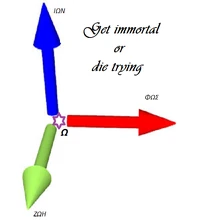Χαμιλτονιανή

Χαμιλτονιανή Μηχανική
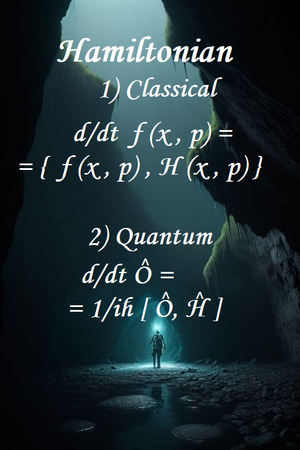
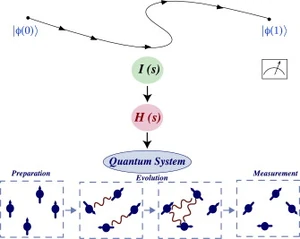
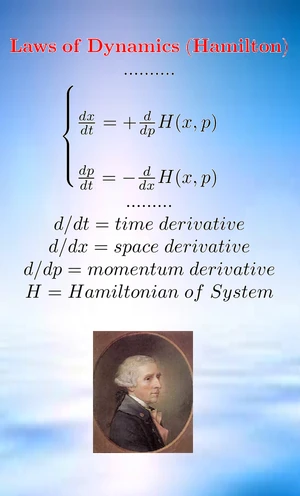
Κλασσική Δυναμική
Χαμιλτονιανή
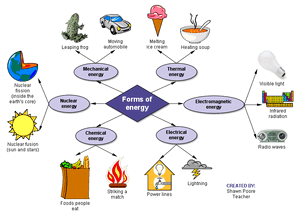
Ακτινοβολία
Ενέργεια (φυσικό μέγεθος)
Μηχανική Ενέργεια
Κινητική Ενέργεια
Δυναμική Ενέργεια
Έργο
Ελαστική Ενέργεια
Δυναμικό
Βαρυτική Ενέργεια
Λαγρασιανή (Lagrangian)
Χαμιλτονιανή (Hamiltonian)
Θερμική Ενέργεια
Θερμότητα
Εσωτερική Ενέργεια
Ενθαλπία
Ελεύθερη Ενέργεια Helmholtz
Ελεύθερη Ενέργεια Gibbs
Χημική Ενέργεια
Ηλεκτρομαγνητική Ενέργεια
Ηλεκτρική Ενέργεια
Μαγνητική Ενέργεια
Ηλεκτρικό Δυναμικό
Μαγνητικό Δυναμικό
Ηλεκτρική Τάση
Επαγωγική Τάση
Ιονίζουσα Ενέργεια
Πυρηνική Ενέργεια
Ενέργεια Μηδενικού Σημείου
Σκοτεινή Ενέργεια
Big Bang
Αρχή Διατήρησης Ενέργειας
Ισοδυναμία Μάζας - Ενέργειας
1ος θερμοδυναμικός Νόμος
2ος Θερμοδυναμικός Νόμος
Ενέργειες
Ενεργειακές Πηγές
Πεδία
Οικονομική Ενέργεια
Χρήμα
Φυσικός Πόρος
Ενεργειακή Παραγωγή
Υδροηλεκτρικό Εργοστάσιο
Ατμοηλεκτρικό Εργοστάσιο
Υπερβατικές Ενέργειες
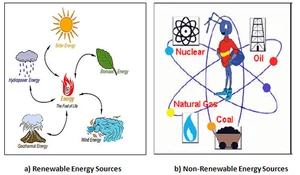
Μη-Ανανεώσιμη Ενέργεια
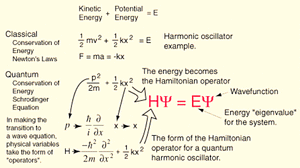
Εξίσωση Schrodinger
Αρχή Διατήρησης Μηχανικής Ενέργειας
Χαμιλτονιανή
Κινητική Ενέργεια
Δυναμική Ενέργεια
Ιδιοτιμή
Ιδιοσυνάρτηση
Τελεστής
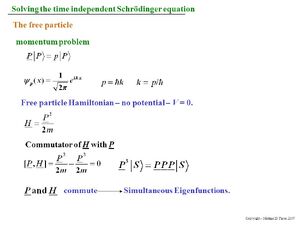
Ορμή
- Μια μαθηματική συνάρτηση που παριστάνει μαθηματικά τον τρόπο με τον οποίο αλληλεπιδρούν μεταξύ τους, αλλά και με τα πεδία, τα διάφορα σωματίδια.
Ετυμολογία[]
Η ονομασία "Χαμιλτονιανή" προέρχεται από τον διάσημο φυσικό Hamilton.
Ορισμός[]
Στην Κλασσική Φυσική, η Ηamiltonian Η είναι το άθροισμα της κινητικής ενέργειας Κ συν την δυναμική ενέργεια V που κατέχει το εξεταζόμενο φυσικό σύστημα .
Η εξίσωση που την καθορίζει είναι η εξής:
- H = K + V
Φυσική Σημασία[]
The Hamiltonian is an important quantity that characterizes a physical body or system in Classical Mechanics and Quantum Mechanics. The Hamiltonian is useful in obtaining powerful equations of motion for a system in classical mechanics, the so called 'canonical equations', and is an essential quantity in the Schroedinger Equation in non-relativistic quantum mechanics.
In many physical situations it is equal to the total kinetic energy plus the total potential engergy, but this is not necessarily the case.
The Hamiltonian function is defined as:
h = Σj (∂L/∂q'j) q'j - L(qk,q'k,t)
where the q's are the generalized coordinates,1 where ' indicates the time derivative of the quantity in question, and where L(qk,q'k,t) is the Lagrangian function expressed in the generalized coordinates and generalized velocities. The Lagrangian function of a body or system is equal to the Kinetic Energy minus the Potential Energy, or, in symbols: L(qk,q'k,t) = T - U.
In general, the Hamiltonian is expressed as a function of the generalized coordinates, the generalized momenta, and the time: H = H(qk,pk,t)
In Lagrangian mechanics we can define generalized momenta corresponding to the generalized coordinates*.
pj = ∂L/∂q'j. This allows us to rewrite the Hamiltonian
H = Σj q'jpj - L(qk,q'k,t)
In a so-called monogenic system, one in which the potential energies involved do not depend on the generalized velocities, the differentials of the Hamiltonian and the Lagrangian are such that the following must be true: q'j = ∂H/∂pj and p'j = - ∂H/∂qj also ∂H/∂t = - ∂L/∂q
These equations are the canonical equations of motion, and since they relate the time derivative, and therefore the change in time, of the generalized coordinates and generalized momenta to the Hamiltonian in any system where the potential energy is not an explicit function of the generalized velocities. This Hamiltonian can be determined, and then they theoretically tell us everything we need to know about the evolution of a system. This is provided, of course, that we pick meaningful generalized coordinates and can solve the necessary equations.
If the Lagrangian is not explicitly a function of time, as is the case in a closed system, then by the equation above the Hamiltonian is a constant.
If the potential energy term appearing in the Lagrangian does not depend on the generalized velocities, and the generalized coordinates used to express the Hamiltonian are so-called scleronomic, meaning that the equations that transform them from ordinary cartesian coordinates don't explicitly contain the time, then we also know from Lagrangian Mechanics that Σj qj dT/dq'j = 2T, so then the Hamiltonian is 2T - (T - U) = T + U = E.
So in the case that the generalized coordinates are scleronomic, and of course that the potential energy is not an explicit function of the generalized velocities, then the Hamiltonian is equal to the total energy: H = T + U and, of course, T is a function only of velocity and from the conditions before U is a function only of position.
In this case where the Hamiltonian is equal to the total energy and we are working in cartesian coordinates, it can, by elementary mechanics, be expressed (in the non-relativistic case, of course) as H = p^2/2m + U(x) where p is the ordinary momentum.
The Hamiltonian enters into the Shroedinger Equation of Quantum Mechainics as an operator, which states that H(hat) ψ = i hbar ∂Ψ/∂t, where H(hat) is the Hamiltonian operator, and Ψ is the wave function.
The physical significance of the Hamiltonian is rather mystical and subtle, but extremely important. It can be seen as the generator of system evolution in time. It can also be seen as the conjugate momentum to time, meaning that if time is thought of a generalized coordinate, the momentum corresponding to that coordinate will be the Hamiltonian, just as the momentum corresponding to a Cartesian coordinate is the familiar linear momentum.
The Hamiltonian is named for Sir William Rowan Hamilton (1805-1865), an Irish Mathematician who articulated Hamilton's Principle, which motivated much of the development of Lagrangian Mechanics.
Ν.Β. Generalized coordinates are analagous to regular 'cartesian' coordinates in that they are quanities that discribe a system and can change as it evolves over time. However, they need not be lengths, indeed they can be angles, volumes, or almost anything. The cooresponding generalized velocities are the time derivatives of the generalized coordinates, just as regular velocity is the time derivative of cartesian coordinates. A generalized momentum, however, is defined as the as the partial derivative of the Lagrangian with respect to the corresponding generalized coordinate, which happens to be the regular momentum in the case of a cartesian coordinate. For more information, see Lagrangian mechanics.
Ανάλυση[]
Η χρονική εξέλιξη του συστήματος περιγράφεται από ένα μετασχηματισμό με γεννήτορα την Χαμιλτονιανή συνάρτηση. Δηλαδή η εξέλιξη του συστήματος μπορεί να θεωρηθεί ως ένας μετασχηματισμός που παράγεται από τις εξισώσεις Hamilton με παράμετρο τον χρόνο και γεννήτορα την Χαμιλτονιανή.
Εάν δεν μεταβάλλεται με το χρόνο, είναι αναλλοίωτη δηλαδή στην κλάση των χρονικών μετασχηματισμών τότε είναι μία διατηρήσιμη ποσότητα.
Εάν η Χαμιλτονιανή δεν εξαρτάται άμεσα από το χρόνο, οπότε δε μεταβάλλεται ως προς τις χρονικές μεταθέσεις τότε είναι σταθερά της κίνησης.
Κβαντική Χαμιλτονιανή[]
Στην Κβαντική Φυσική η Hamiltonian H είναι το παρατηρούμενο μέγεθος (observable) που αντιστοιχεί στην ολική (total energy) ενός κβαντικού συστήματος.
Η χαμιλτονιανή είναι ο τελεστής που αντιστοιχεί στη συνολική ενέργεια ενός κβαντομηχανικού συστήματος.
Συνήθως συμβολίζεται με H ή Ȟ ή Ĥ. Οι ιδιοτιμές της χαμιλτονιανής ενός συστήματος (ή πιο γενικά το «φάσμα» της όταν ο τελεστής δρα σε απειροδιάστατο Χώρο Hilbert, δηλαδή όταν έχουμε πρόβλημα πολλών σωμάτων ή πρόβλημα κβαντικού πεδίου) αποτελούν το σύνολο των πιθανών αποτελεσμάτων μέτρησης της ενέργειας του συστήματος.
Λόγω της στενής σχέσης της με τη χρονική εξέλιξη ενός συστήματος, η χαμιλτονιανή είναι θεμελιώδους σημασίας στους περισσότερους από τους υπάρχοντες μαθηματικούς φορμαλισμούς της κβαντικής θεωρίας.
Σύμφωνα με την Kβαντομηχανική, η αρχή αβεβαιότητας είναι θεμελιώδες χαρακτηριστικό των φυσικών σωμάτων και μεγεθών, και όχι πχ μια αδυναμία στην ακρίβεια μετρήσεων των μετρητικών συσκευών που σήμερα είναι διαθέσιμες τεχνολογικά. Τούτο είναι εμπεδωμένο στο μαθηματικό φορμαλισμό και αντιστοιχεί στο γεγονός ότι οι μεταβλητές ενός φυσικού συστήματος δεν είναι απλές πραγματικές και συνεχείς συναρτήσεις των «κλασσικών» ανεξάρτητων μεταβλητών θέση, χρόνος, κ.ο.κ..
Αντί αυτού, σε κάθε φυσικό μέγεθος αντιστοιχίζεται ένας τελεστής που δρα επί των κβαντικών καταστάσεων του συστήματος, και οι παρατηρήσιμες/μετρήσιμες ποσότητες είναι οι ιδιοτιμές αυτοσυζυγών γραμμικών τελεστών.
Έτσι, για παράδειγμα, μια πολύ συνηθισμένη μορφή που λαμβάνει η Χαμιλτονιανή (όχι ο τεχνικά ακριβής ορισμός αλλά μια συνηθισμένη μορφή) αντιστοιχεί στο «κλασσικό» άθροισμα της κινητικής και δυναμικής ενέργειας με τα αντίστοιχα μεγέθη εκφρασμένα ως τελεστές,
όπου, ο τελεστής της κινητικής ενέργειας προκύπτει από τη σχέση
και τον τελεστή της ορμής
το σύμβολο είναι ο διαφορικός τελεστής, πχ σε καρτεσιανό σύστημα συντεταγμένων ίσος με (ο διαφορικός τελεστής δίνει την παράγωγο των καταστάσεων του συστήματος)
και ο τελεστής δυναμικής ενέργειας λαμβάνει τη μορφή μιας συνάρτησης της θέσης και του χρόνου , (ο τελεστής σε αυτή την περίπτωση είναι απλά ένας παράγοντας επί τον οποίο πολλαπλασιάζονται οι καταστάσεις του συστήματος).
Basic physical interpretation[]
The simplest interpretation of the Hamilton equations is as follows, applying them to a one-dimensional system consisting of one particle of mass m under time-independent boundary conditions: The Hamiltonian represents the energy of the system (provided that there are NO external forces, or additional energy added to the system), which is the sum of kinetic and potential energy, traditionally denoted T and V, respectively. Here q is the coordinate and p is the momentum, mv. Then
Note that T is a function of p alone, while V is a function of q alone.
Now the time-derivative of the momentum p equals the Newtonian force, and so here the first Hamilton equation means that the force on the particle equals the rate at which it loses potential energy with respect to changes in its location. (Force equals the negative gradient of potential energy.)
The time-derivative of q means the velocity: the second Hamilton equation here means that the particle’s velocity equals the derivative of its kinetic energy with respect to its momentum. (Because the derivative with respect to p of p2/2m equals p/m = mv/m = v.)
Technique of using Hamilton's equations[]
Hamilton's equations are used in the following way. In terms of the generalized coordinates qi and generalized velocities q̇i:
- The Lagrangian is found, .
- The momenta are calculated by differentiating the Lagrangian with respect to the (generalized) velocities: .
- The velocities q̇i are expressed in terms of the momenta pi by inverting the expressions in the previous step.
- The Hamiltonian is calculated using the usual definition of H as the Legendre transformation of L: . Then the velocities are substituted for using the previous results.
- Hamilton's equations are applied, to obtain the equations of motion of the system.
Deriving Hamilton's equations[]
Hamilton's equations can be derived by looking at how the total differential of the Lagrangian depends on time, generalized positions and generalized velocities [1]
Now the generalized momenta were defined as and Lagrange's equations tell us that
We can rearrange this to get
and substitute the result into the total differential of the Lagrangian
We can rewrite this as
and rearrange again to get
The term on the left-hand side is just the Hamiltonian that we have defined before, so we find that
where the second equality holds because of the definition of the total differential of in terms of its partial derivatives. Associating terms from both sides of the equation above yields Hamilton's equations
As a reformulation of Lagrangian mechanics[]
Starting with Lagrangian mechanics, the equations of motion are based on generalized coordinates
and matching generalized velocities
We write the Lagrangian as
with the subscripted variables understood to represent all N variables of that type. Hamiltonian mechanics aims to replace the generalized velocity variables with generalized momentum variables, also known as conjugate momenta. By doing so, it is possible to handle certain systems, such as aspects of quantum mechanics, that would otherwise be even more complicated.
For each generalized velocity, there is one corresponding conjugate momentum, defined as:
In Cartesian coordinates, the generalized momenta are precisely the physical linear momenta. In circular polar coordinates, the generalized momentum corresponding to the angular velocity is the physical angular momentum. For an arbitrary choice of generalized coordinates, it may not be possible to obtain an intuitive interpretation of the conjugate momenta.
One thing which is not too obvious in this coordinate dependent formulation is that different generalized coordinates are really nothing more than different coordinate patches on the same symplectic manifold (see Mathematical formalism, below).
The Hamiltonian is the Legendre transform of the Lagrangian:
If the transformation equations defining the generalized coordinates are independent of t, and the Lagrangian is a sum of products of functions (in the generalized coordinates) which are homogeneous of order 0, 1 or 2, then it can be shown that H is equal to the total energy E = T + V.
Each side in the definition of produces a differential:
Substituting the previous definition of the conjugate momenta into this equation and matching coefficients, we obtain the equations of motion of Hamiltonian mechanics, known as the canonical equations of Hamilton:
Hamilton's equations consist of 2n first-order differential equations, while Lagrange's equations consist of n second-order equations. However, Hamilton's equations usually don't reduce the difficulty of finding explicit solutions. They still offer some advantages, since important theoretical results can be derived because coordinates and momenta are independent variables with nearly symmetric roles.
Hamilton's equations have another advantage over Lagrange's equations: if a system has a symmetry, such that a coordinate does not occur in the Hamiltonian, the corresponding momentum is conserved, and that coordinate can be ignored in the other equations of the set. Effectively, this reduces the problem from n coordinates to (n-1) coordinates. In the Lagrangian framework, of course the result that the corresponding momentum is conserved still follows immediately, but all the generalized velocities still occur in the Lagrangian - we still have to solve a system of equations in n coordinates.[2]
The Lagrangian and Hamiltonian approaches provide the groundwork for deeper results in the theory of classical mechanics, and for formulations of quantum mechanics.
Charged particle in an electromagnetic field[]
A good illustration of Hamiltonian mechanics is given by the Hamiltonian of a charged particle in an electromagnetic field. In Cartesian coordinates (i.e. ), the Lagrangian of a non-relativistic classical particle in an electromagnetic field is (in SI Units):
where e is the electric charge of the particle (not necessarily the electron charge), is the electric scalar potential, and the are the components of the magnetic vector potential (these may be modified through a gauge transformation). This is called minimal coupling.
The generalized momenta may be derived by:
Rearranging, we may express the velocities in terms of the momenta, as:
If we substitute the definition of the momenta, and the definitions of the velocities in terms of the momenta, into the definition of the Hamiltonian given above, and then simplify and rearrange, we get:
This equation is used frequently in quantum mechanics.
Relativistic charged particle in an electromagnetic field[]
The Lagrangian for a relativistic charged particle is given by:
Thus the particle's canonical (total) momentum is
that is, the sum of the kinetic momentum and the potential momentum.
Solving for the velocity, we get
So the Hamiltonian is
From this we get the force equation (equivalent to the Euler–Lagrange equation)
from which one can derive
An equivalent expression for the Hamiltonian as function of the relativistic (kinetic) momentum, is
This has the advantage that can be measured experimentally whereas cannot. Notice that the Hamiltonian (total energy) can be viewed as the sum of the relativistic energy (kinetic+rest), plus the potential energy,
Συμμετρία Χαμιλτονιανής[]
Μία Χαμιλτονιανή θεωρείται ότι έχει μια συγκεκριμένη συμμετρία ή ότι παραμένει αναλλοίωτη υπό τους μετασχηματισμούς μίας ομάδας συμμετρίας, όταν οι γεννήτορες της συγκεκριμένης ομάδας συμμετρίας μετατίθενται με αυτήν.
Συνέπεια της ύπαρξης συμμετρίας είναι η εμφάνιση εκφυλισμών στο φάσμα της Χαμιλτονιανής.
Εκτός από την έννοια της απλής συμμετρίας, υπάρχει και η έννοια της δυναμικής συμμετρίας.
Η Χαμιλτονιανή χαρακτηρίζεται από δυναμική συμμετρία όταν μπορεί να γραφεί ως συνάρτηση των τελεστών Casimir μιας αλυσίδας ομάδων συμμετρίας. (Οι τελεστές Casimir μιας ομάδας συμμετρίας είναι συνδυασμοί των γεννητόρων της ομάδας).
Στην περίπτωση δυναμικής συμμετρίας, οι ιδιοκαταστάσεις της Χαμιλτονιανής χαρακτηρίζονται από τους κβαντικούς αριθμούς όλων των συμμετριών των ομάδων που εμπλέκονται στην αλυσσίδα, ενώ ο εκφυλισμός του φάσματος εκπίπτει.
Οι δυναμικές συμμετρίες έχουν χρησιμοποιηθεί στη μελέτη της πυρηνικής δομής. Μία από τις πρώτες χρήσεις των δυναμικών συμμετριών ήταν στα πλαίσια του SU(3) προτύπου του Elliott, που χρησιμοποιείται για την περιγραφή ελαφρών, μη σφαιρικών πυρήνων του s-d φλοιού.
Στα πλαίσια του προτύπου των φλοιών μια ανάλογη προσπάθεια για την περιγραφή παραμορφωμένων πυρήνων επιτεύχθηκε με το πρότυπο του Nilsson, το οποίο υπολογίζει ενέργειες σύνδεσης νουκλεονίων σε παραμορφωμένο δυναμικό. ́
Αλλο παράδειγμα χρήσης δυναμικής συμμετρίας είναι στα πλαίσια του προτύπου των αλληλεπιδρώντων βοσονίων (Interacting Boson Model (IBM)), με τις τρεις δυναμικές του συμμετρίες, U(5), SU(3) και Ο(6), οι οποίες περιγράφουν σφαιρικούς δονητικούς, ωοειδείς αξονικά συμμετρικούς πυρήνες και πυρήνες ασταθείς ως προς την αξονική συμμετρία (γ - ασταθείς πυρήνες), αντίστοιχα.
Η ρήξη μιας συμμετρίας μπορεί να οδηγήσει στην εμφάνιση προσεγγιστικών συμμετριών, οι οποίες μπορούν να αναγνωρισθούν, εκτός των άλλων μεθόδων και με Χαοτική μεθοδολογία.
Η ρήξη της συμμετρίας SU(3) στους βαρείς πυρήνες, στο πρότυπο του Elliott, οδήγησε στην ανάπτυξη ενός προτύπου που βασίζεται σε μία προσεγγιστική συμμετρία SU(3), το ψευδο-SU(3) σχήμα, κατάλληλο για την περιγραφή βαρέων πυρήνων.
Η ρήξη των συμμετριών στα πλαίσια του ΙΒΜ, έχει οδηγήσει σε νέες προσεγγιστικές συμμετρίες, τις επεκταμένες έννοιες των Μερικώς Δυναμικών Συμμετριών και Ψευδο-Δυναμικών Συμμετριών.
Υποσημειώσεις[]
- ↑ This derivation is along the lines as given in Πρότυπο:Harvnb
- ↑ Goldstein, H. (2001), Classical Mechanics (3rd έκδοση), Addison-Wesley, ISBN 0-201-65702-3
Εσωτερική Αρθρογραφία[]
Βιβλιογραφία[]
- Berkeley Physics Course, Vol IV, 1971
Ιστογραφία[]
- Ομώνυμο άρθρο στην Βικιπαίδεια
- Ομώνυμο άρθρο στην Livepedia
- Quantum Field Theory
- Relativistic Quantum Field Theory, Vries
|
Αν και θα βρείτε εξακριβωμένες πληροφορίες "Οι πληροφορίες αυτές μπορεί πρόσφατα Πρέπει να λάβετε υπ' όψη ότι Επίσης, |
- Μην κάνετε χρήση του περιεχομένου της παρούσας εγκυκλοπαίδειας
αν διαφωνείτε με όσα αναγράφονται σε αυτήν
- Όχι, στις διαφημίσεις που περιέχουν απαράδεκτο περιεχόμενο (άσεμνες εικόνες, ροζ αγγελίες κλπ.)



















![{\displaystyle \mathrm {d} {\mathcal {L}}=\sum _{i}\left[{\dot {p}}_{i}\mathrm {d} q_{i}+p_{i}\mathrm {d} {{\dot {q}}_{i}}\right]+{\frac {\partial {\mathcal {L}}}{\partial t}}\mathrm {d} t\,.}](https://services.fandom.com/mathoid-facade/v1/media/math/render/svg/7be1c5b2473f20c40c54597dcf4df042ec87b820)
![{\displaystyle \mathrm {d} {\mathcal {L}}=\sum _{i}\left[{\dot {p}}_{i}\mathrm {d} q_{i}+\mathrm {d} \left(p_{i}{{\dot {q}}_{i}}\right)-{{\dot {q}}_{i}}\mathrm {d} p_{i}\right]+{\frac {\partial {\mathcal {L}}}{\partial t}}\mathrm {d} t\,}](https://services.fandom.com/mathoid-facade/v1/media/math/render/svg/01ef462802cb94869d5751239811c0b4ae07d012)
![{\displaystyle \mathrm {d} \left(\sum _{i}p_{i}{{\dot {q}}_{i}}-{\mathcal {L}}\right)=\sum _{i}\left[-{\dot {p}}_{i}\mathrm {d} q_{i}+{{\dot {q}}_{i}}\mathrm {d} p_{i}\right]-{\frac {\partial {\mathcal {L}}}{\partial t}}\mathrm {d} t\,.}](https://services.fandom.com/mathoid-facade/v1/media/math/render/svg/e5ab81ecc6769dc35da48afbfee45e9f3fde368b)
![{\displaystyle \mathrm {d} {\mathcal {H}}=\sum _{i}\left[-{\dot {p}}_{i}\mathrm {d} q_{i}+{{\dot {q}}_{i}}\mathrm {d} p_{i}\right]-{\frac {\partial {\mathcal {L}}}{\partial t}}\mathrm {d} t=\sum _{i}\left[{\frac {\partial {\mathcal {H}}}{\partial q_{i}}}\mathrm {d} q_{i}+{\frac {\partial {\mathcal {H}}}{\partial p_{i}}}\mathrm {d} p_{i}\right]+{\frac {\partial {\mathcal {H}}}{\partial t}}\mathrm {d} t\,}](https://services.fandom.com/mathoid-facade/v1/media/math/render/svg/f177425cfb4fef82e6fcfbf688d45f7f5ff34d4c)






![{\displaystyle {\begin{aligned}\mathrm {d} {\mathcal {H}}&=\sum _{i}\left[\left({\partial {\mathcal {H}} \over \partial q_{i}}\right)\mathrm {d} q_{i}+\left({\partial {\mathcal {H}} \over \partial p_{i}}\right)\mathrm {d} p_{i}\right]+\left({\partial {\mathcal {H}} \over \partial t}\right)\mathrm {d} t\qquad \qquad \quad \quad \\\\&=\sum _{i}\left[{\dot {q}}_{i}\,\mathrm {d} p_{i}+p_{i}\,\mathrm {d} {\dot {q}}_{i}-\left({\partial {\mathcal {L}} \over \partial q_{i}}\right)\mathrm {d} q_{i}-\left({\partial {\mathcal {L}} \over \partial {\dot {q}}_{i}}\right)\mathrm {d} {\dot {q}}_{i}\right]-\left({\partial {\mathcal {L}} \over \partial t}\right)\mathrm {d} t.\end{aligned}}}](https://services.fandom.com/mathoid-facade/v1/media/math/render/svg/e777bd3ed84a9853dea52c10ff47f1a6703ebe34)








![{\displaystyle {\mathcal {L}}[t]=-mc^{2}{\sqrt {1-{\frac {{{\dot {\vec {x}}}[t]}^{2}}{c^{2}}}}}-e\phi [{\vec {x}}[t],t]+e{\dot {\vec {x}}}[t]\cdot {\vec {A}}[{\vec {x}}[t],t]\,.}](https://services.fandom.com/mathoid-facade/v1/media/math/render/svg/d1c99baf844a392d12a972d6c5fb65f7466acda8)
![{\displaystyle {\vec {P}}\,[t]={\frac {\partial {\mathcal {L}}[t]}{\partial {\dot {\vec {x}}}[t]}}={\frac {m{\dot {\vec {x}}}[t]}{\sqrt {1-{\frac {{{\dot {\vec {x}}}[t]}^{2}}{c^{2}}}}}}+e{\vec {A}}[{\vec {x}}[t],t]\,,}](https://services.fandom.com/mathoid-facade/v1/media/math/render/svg/5be545461f330db88e87e92ec43dbc1063e02259)
![{\displaystyle {\dot {\vec {x}}}[t]={\frac {{\vec {P}}\,[t]-e{\vec {A}}[{\vec {x}}[t],t]}{\sqrt {m^{2}+{\frac {1}{c^{2}}}{\left({\vec {P}}\,[t]-e{\vec {A}}[{\vec {x}}[t],t]\right)}^{2}}}}\,.}](https://services.fandom.com/mathoid-facade/v1/media/math/render/svg/ea05c41b46a58db141b070155e40ef86249c580b)
![{\displaystyle {\mathcal {H}}[t]={\dot {\vec {x}}}[t]\cdot {\vec {P}}\,[t]-{\mathcal {L}}[t]=c{\sqrt {m^{2}c^{2}+{\left({\vec {P}}\,[t]-e{\vec {A}}[{\vec {x}}[t],t]\right)}^{2}}}+e\phi [{\vec {x}}[t],t]\,.}](https://services.fandom.com/mathoid-facade/v1/media/math/render/svg/a972605ae9209faf828700d257ddaa1727311fb2)


![{\displaystyle {\vec {p}}=\gamma m{\dot {\vec {x}}}[t]\,,}](https://services.fandom.com/mathoid-facade/v1/media/math/render/svg/87b7b323b47ad5dad06839814e1f97229561bb1b)
![{\displaystyle {\mathcal {H}}[t]={\dot {\vec {x}}}[t]\cdot {\vec {p}}\,[t]+{\frac {mc^{2}}{\gamma }}+e\phi [{\vec {x}}[t],t]=\gamma mc^{2}+e\phi [{\vec {x}}[t],t]=E+V\,.}](https://services.fandom.com/mathoid-facade/v1/media/math/render/svg/68ee6cd60e6cfccb9d374b26c495a026196f8a15)




